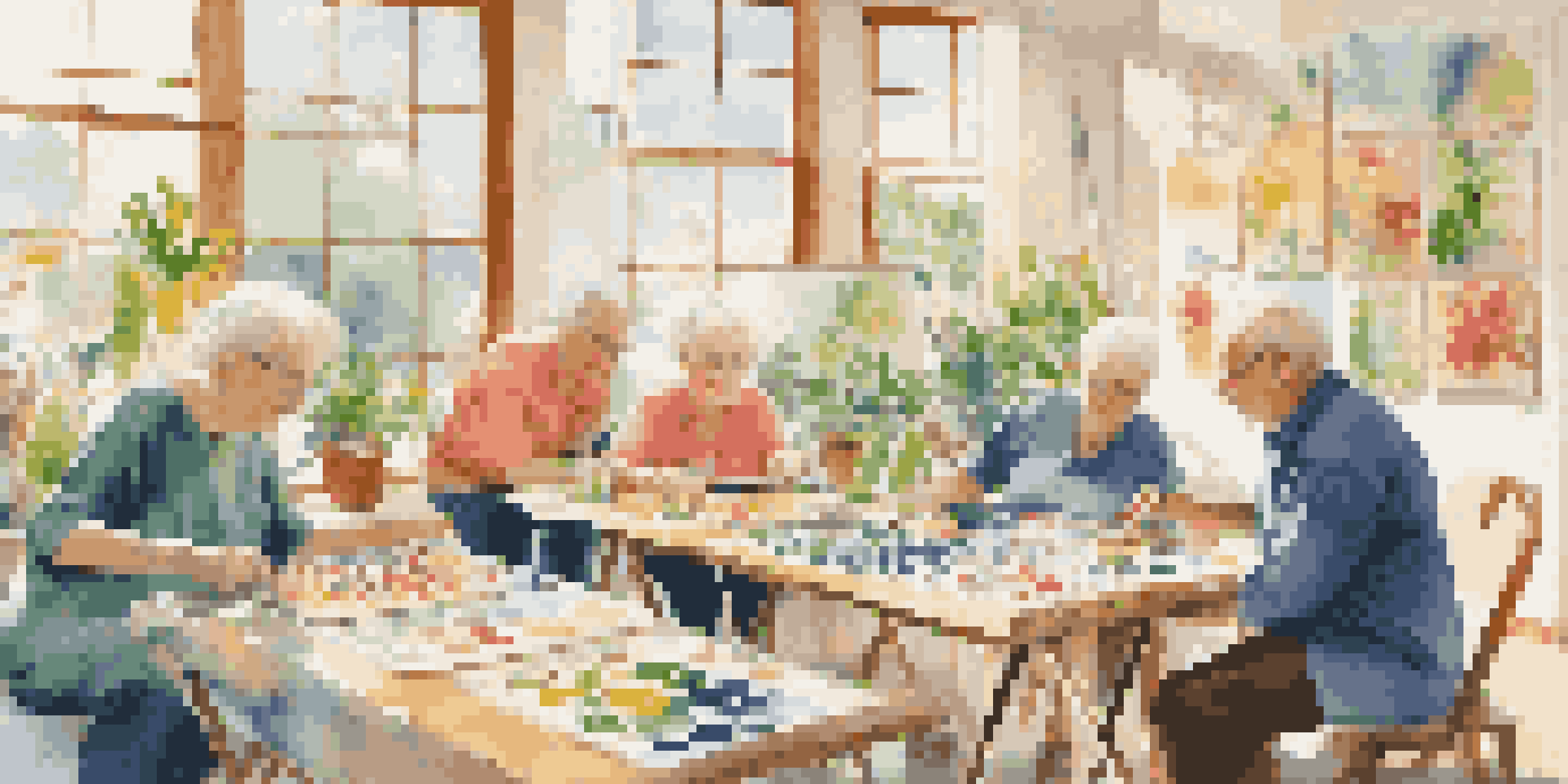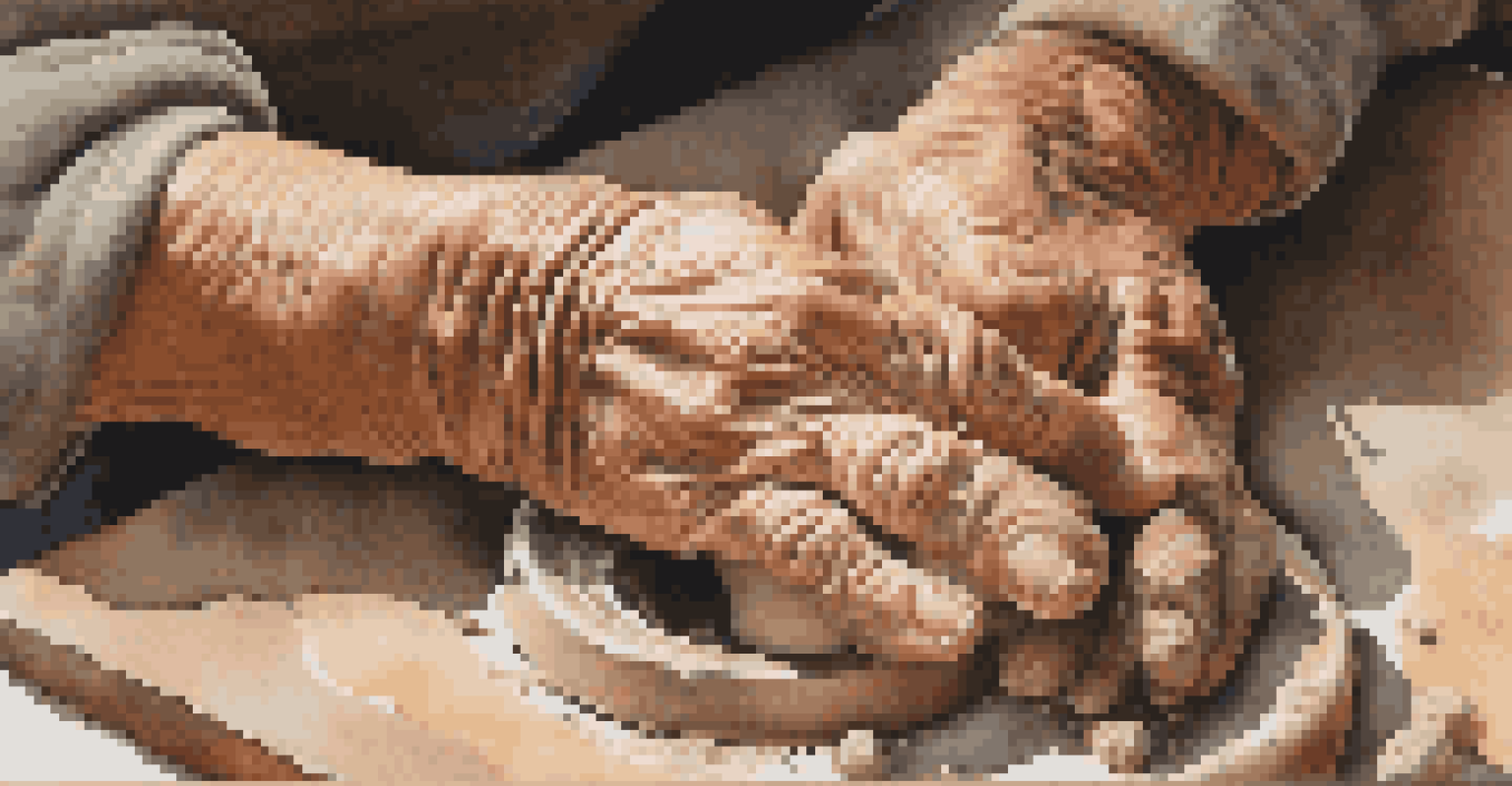Art and the Aging Population: Engaging Seniors Creatively

The Importance of Art in Senior Life
Art plays a vital role in enhancing the quality of life for seniors. It provides an outlet for expression and can evoke emotions that contribute to mental well-being. Engaging in creative activities can also foster social connections, reducing feelings of isolation that many seniors experience.
Art is the most beautiful of all lies.
Moreover, art stimulates cognitive functions, helping to keep the mind sharp and engaged. Studies show that artistic activities can improve memory and critical thinking skills, which are crucial in maintaining overall health. Simple activities like painting or crafting can lead to significant mental benefits.
Incorporating art into the daily lives of seniors not only nurtures their creativity but also brings joy and fulfillment. By participating in art, they can explore their identity and experiences, which is particularly important as they navigate the challenges of aging.
Different Forms of Artistic Expression
There are numerous forms of artistic expression that seniors can explore, from painting and drawing to music and dance. Each medium offers unique benefits and can be adapted to suit different abilities and preferences. For instance, painting allows for freedom of expression without the need for physical exertion.

Music, on the other hand, can evoke nostalgia and stimulate memories, creating a rich emotional experience. Group music sessions or sing-alongs can also enhance social interactions, making it a great way to connect with others. Dance can be adapted to various fitness levels, encouraging both physical movement and enjoyment.
Art Enhances Seniors' Well-Being
Engaging in artistic activities improves mental health, fosters social connections, and stimulates cognitive functions in seniors.
In addition, crafts like knitting or pottery provide a tactile experience that can be soothing and satisfying. Engaging in these activities not only fosters creativity but also promotes fine motor skills, which can decline with age. Each art form can be a gateway to self-discovery and emotional expression.
Benefits of Art Therapy for Seniors
Art therapy is a specialized form of therapy that utilizes creative processes to help individuals express themselves. For seniors, it can be particularly beneficial in addressing emotional or psychological issues, including depression and anxiety. Through guided artistic activities, seniors can explore their feelings in a safe and supportive environment.
Creativity takes courage.
Moreover, art therapy can help improve communication skills, especially for those who may struggle to articulate their thoughts and emotions verbally. This can be especially significant for seniors dealing with conditions like dementia, where their ability to communicate may be compromised. Art becomes a bridge, allowing them to connect with caregivers and loved ones.
Participating in art therapy also reinforces a sense of accomplishment. Completing a project can boost self-esteem and provide a sense of purpose, which is essential for mental health. The therapeutic benefits of art create a holistic approach to care, integrating emotional, social, and cognitive well-being.
Creating Community Through Art Programs
Art programs specifically designed for seniors can create a strong sense of community and belonging. These programs often encourage collaboration and teamwork, fostering relationships among participants. When seniors come together to create, they build connections that can lead to lasting friendships.
Community art projects not only enhance social bonds but also allow seniors to contribute meaningfully to their neighborhoods. For example, murals or public art installations can be collaborative efforts that involve multiple participants, instilling pride and ownership in the final product. It’s a win-win situation where creativity meets community spirit.
Art Therapy Supports Emotional Health
Art therapy provides seniors with a safe space to express emotions, enhancing communication and boosting self-esteem.
Additionally, these programs can provide a platform for seniors to share their stories and experiences, enriching the lives of all involved. By engaging creatively, seniors not only express themselves but also inspire younger generations, creating a dialogue that transcends age and fosters inclusivity.
Technology and Art: Bridging the Gap
In today's digital age, technology has opened up new avenues for artistic expression among seniors. Online platforms and virtual classes have made art more accessible, allowing seniors to explore their creativity from the comfort of their homes. This is especially beneficial for those with mobility issues or those who live in remote areas.
Digital art tools, such as graphic design software or apps for drawing, can spark interest in technology while promoting creativity. These tools are often intuitive and user-friendly, making it easier for seniors to engage without feeling overwhelmed. Moreover, incorporating technology can enhance their learning experience, allowing them to experiment with different styles and techniques.
Additionally, social media offers a way for seniors to showcase their artwork and connect with other artists. Sharing their creations online can validate their efforts and provide encouragement. This digital engagement not only keeps them creatively active but also helps combat loneliness by fostering a sense of community.
Art as a Tool for Memory Care
Art can serve as a powerful tool in memory care, particularly for seniors with cognitive impairments like Alzheimer’s disease. Engaging in creative activities can spark memories and stimulate conversations, providing a sense of familiarity and comfort. For example, working on a scrapbook can help trigger cherished memories associated with photos and mementos.
Moreover, familiar artistic activities can offer structure and routine, which are beneficial for those with memory loss. Simple tasks like coloring or painting can provide a sense of accomplishment and reduce anxiety. When seniors engage in art, they focus on the present moment, which can help alleviate some of the stress associated with memory-related challenges.
Community Art Builds Connections
Art programs for seniors create a sense of belonging and encourage collaboration, leading to meaningful friendships and community engagement.
Finally, art can create opportunities for family members to connect with their loved ones. Participating in art activities together allows for shared experiences that can strengthen relationships. These moments of connection can be invaluable, providing joy and meaning in the midst of memory loss.
Encouraging Lifelong Creativity in Seniors
Encouraging creativity in seniors is essential for fostering a fulfilling and engaged life. It’s never too late to pick up a paintbrush, learn an instrument, or explore new artistic avenues. By promoting lifelong creativity, we help seniors maintain a sense of purpose and joy.
Support from family members and caregivers plays a crucial role in this journey. By providing encouragement and resources, they can help seniors discover their artistic passions. Whether it’s enrolling them in a class or simply setting up a creative space at home, small actions can have a significant impact.

Ultimately, fostering creativity in seniors enriches their lives and helps them navigate the challenges of aging with grace and resilience. Every brushstroke, note, or crafted piece contributes to a vibrant tapestry of experiences that celebrates their individuality.